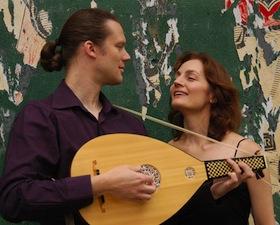
Although museums and classical music are both part of “the arts,” art historians often have minimal understanding of music and music history. This was readily apparent on Sunday afternoon when San Francisco’s Palace of the Legion of Honor presented New York–based Asteria — a fine early-music duo — in a program of medieval love songs from the mid-15th-century court of Charles the Bold. It seemed the museum did everything in its power to create the least favorable environment for Asteria’s polished rendition of intimate music of Busnoys, Robert Morton, and Hayne van Ghizeghem. Museums spend thousands of dollars installing the correct lighting for each artwork they display; they need to devote the same care to music presentation if they continue to include it in their offerings.
Entering the theater, the audience took their seats while Asteria’s recordings played in the background. The concert started late and was then introduced by a representative from the museum who stumbled over the performers’ names (Sylvia Rhyne, soprano, and Eric Redlinger, lute and tenor) and then launched into a multipage recitation of their biographies straight from the program. The speaker was utterly unprepared, stumbling over and mispronouncing at least 30 foreign words and European cities. She also used incorrect music terminology to summarize a lecture held earlier that day. This was embarrassing when one expects curatorial authority.
The printed program was a hastily photocopied affair from an arts management website with irrelevant information about different program packages available, text cut off, and big black blobs I assumed to be photographs. Even though translations were provided for those not fluent in medieval Burgundian, they became useless once the house lights were darkened. When the unlucky performers finally took the stage, they had to announce gracefully they would cut their program short due to an organ recital starting in 45 minutes. Redlinger often focused on the clock while playing.
Redlinger’s very light tenor ... revealed dead-accurate intonation and great musical sensitivity.
Just like shining the wrong light on a beautiful woman can make her look sickly, the wrong acoustic space can break a performance. The acoustically dead Florence Gould Theater at the museum is more suitable for a rock concert or a chemistry lecture than this delicate, soft music. It did not help to hang the shaggiest, most noise-baffling curtain right behind the performers. This was sad, because the Legion of Honor has 20 or so galleries that are acoustically ideal spaces for this music: reverberant, warm, and intimate. It would have been thrilling to hear this music next to artworks from its time. Wandering visitors would have been no more of a problem than in the theater, with its numerous latecomers slamming the entrance door.
Trying to Focus on the Music
In this unflattering space, I had to work hard not to focus on Asteria’s imperfections while they sang numerous “bergerette” duets typical of the period. I gradually warmed to Redlinger’s very light tenor, which initially struck me as amateurish but revealed dead-accurate intonation and great musical sensitivity as time wore on, especially in Mouton’s N’auray-je jamais mieux. In a “wet acoustic” space, his voice would have carried better. His lute playing was very clean, and his multitasking commendable. Rhyne sang with an easy and soft tone I usually associate with folk singing. Both performers sang from memory and coordinated their gestures without going too far in the ABBA direction.
In contrast with the thoughtful art display, the concert felt like an afterthought.
Rhyne, a compelling speaker, gave an account of how she and Redlinger had spent time in France over the past few years to tour the countryside and make the first transcription of Busnoys’ works from a manuscript in Dijon. The fruit of Asteria’s effort was a supposed modern “premiere” of the work Au gre de mes Yeulx that had “never been transcribed.” This research in Dijon was highlighted in the concert’s press release. Actually, Busnoys’ work was transcribed, edited, and published by German musicologist Clemens Goldberg in 1994 (page 343 of Die Chansons von Antoine Busnois: Die Asthetik der hofischen Chansons). Considering that Redlinger did postgraduate studies in musicology at the Frankfurt Conservatory of Music, I considered it a gross misrepresentation to claim the virelai as a new discovery.
Although my treatment of the Legion of Honor’s inexperience with music presentation might seem unnecessarily harsh, I dwell on it because the museum competes for the same limited pool of cultural dollars as hundreds of other Bay Area performing arts groups — most of which know what they’re doing. This free concert was funded by the Annenberg Foundation in conjunction with a special exhibition of art from Burgundy, “The Mourners.” In contrast with the thoughtful art display, the concert felt like an afterthought rather than an essential way to understand cultural history through the genre of courtly love. There is great potential in a museum-sponsored concert series, but it requires a strong music curator.

